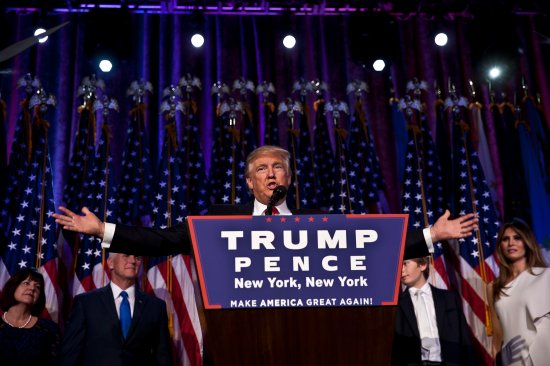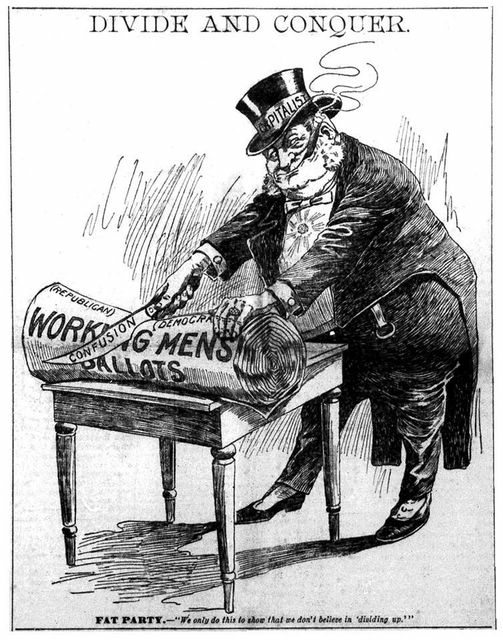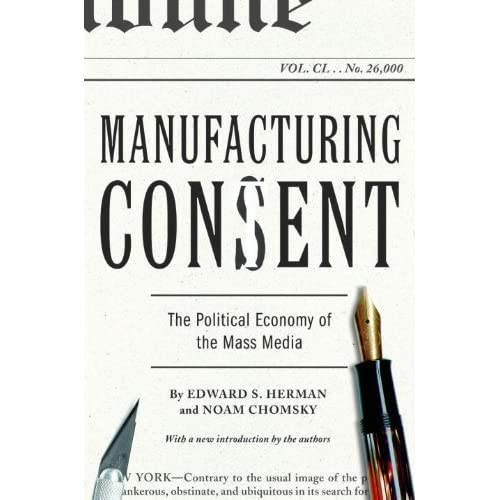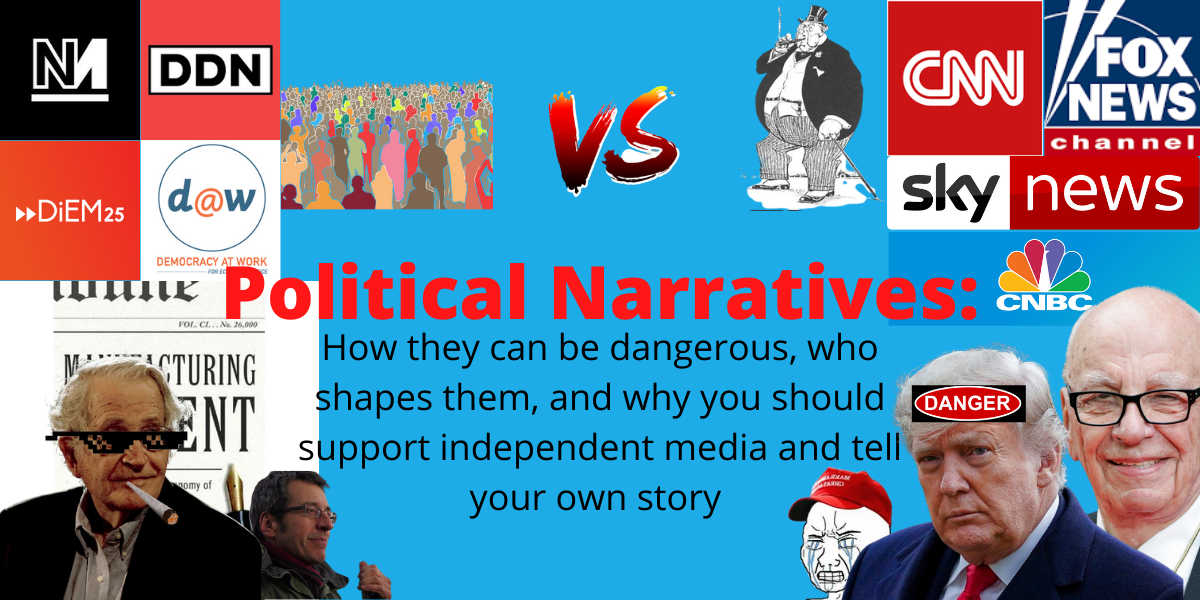Storytelling
The journalist and writer George Monbiot has pointed out that political failure is at heart a failure of imagination, and to trigger imagination we need narrative. Broad political movements all have their own narrative. Those narratives have a villain or villains who is the cause of the bad and disorder in the world and a hero or heros who will restore, or bring about order. Put simply, you can use all the stats and figures that you want, but at the end of the day it is these stories of good (whatever/whoever that is) vs evil (whatever/whoever that is), that attracts people. A good storyteller will be more popular than a good statistician.

Image: (Dave Stelfox/Verso Books)
Although a Good politician would articulate his views with a strong story/narrative behind it, while standing up for the rights of all people, it doesn’t always pan out that way. It goes especially wrong when a politician uses a strong narrative, but quite frankly wants to trample over the rights of certain people.
Donald Trump
On November 9, 2016, 2:45 am, Donald John Trump was projected as the winner of the United States presidential election, becoming president-elect. This followed a campaign of racist and misogynistic lies, along with the usual classism of the Republican party (but that’s a given). Trump was different from the other Republicans. Trump said the quiet part out loud. A lot of Republicans before him had been calling for the exact same policies as him, but it was full of euphemisms. Instead of “Illegal immigrants” and the Democrats being the villains, in his narrative Trump specifically went after Mexicans, Muslims and Hillary Clinton and the “Liberal elite”. Trump’s narrative was more visceral, no filter storytelling than the Republicans before him.

Saying the quiet part out loud and using fear
Long gone were the days of Republicans giving out about “illegal immigration”, when in their heads were thinking of Mexicans. Trump said the quiet part out loud. He specifically singled out Mexicans in his infamous speech where he said:
“They’re bringing drugs. They’re bringing crime. They’re rapists. And some, I assume, are good people.”
He also said that Justice Gonzalo P. Curiel, who was born in Indiana, should be disqualified from deciding cases against him because “this judge is of Mexican heritage”.
Long gone were the days of George W Bush saying that Islam was a religion of peace, and Muslims ought to be respected, despite at the same time waging a war in Iraq that killed hundreds of thousands of innocent Muslims, and not even apologising. (Starting the war by using the lie that al-Qaeda was active in Iraq, a lie that could only go on because Iraq is a Muslim majority country)

Trump skipped the looking optically good part and directly attacked Muslims and refugees from Muslim majority countries. An example of this is an interview Donald Trump did in 2015 in which he says of Syrian refugees:
“But if they’re here, they have to go back, because we cannot take a chance. You look at the migration, it’s young, strong men. We cannot take a chance that the people coming over here are going to be ISIS-affiliated.”
Along with his proposal of sending back Syrian refugees, Trump also had a particularly brutal and disgusting tactic when in came to fighting ISIS in Iraq and Syria:
“I would knock the hell out of ISIS… [and] when you get these terrorists, you have to take out their families,” He said on Fox and Friends in late 2015.
He used the fears of the white working class voters, and created the impression of global danger of groups that are deemed to pose a challenge to the nation, instead of focusing on improving the material conditions for working class people, of any colour or creed. He engaged in a tactic of divide and conquer, you could say.

Image: Worker’s Call newspaper 1902
Trump didn’t even do the “pretend to care about the people” part. He just wanted a more visceral narrative in order to whip the people up into a frenzy to support his fake populist movement.
Betrayal of the working class
Now that’s not to say everyone who voted for Trump did so because of this explicitly racist rhetoric. During the campaign, Trump promised to bring manufacturing jobs back to the “Rust Belt”. The “Rust Belt” is an area that has suffered significant economic decline and unemployment since the 70s, due to outsourcing of jobs to poorer countries. This promise worked, with the states of Michigan, Pennsylvania, and Wisconsin all going to Trump. This was, In typical right-wing populist fashion, an empty promise and life for the working class, got worse under Trump.
Taxes were cut for the very wealthiest in society, while at the same time cuts were made on spending for programmes that help the poorest in that country get by. Along with that, Trump attempted to scrap Obamacare, which was legislation brought in by the Obama administration (hence the name), that led to the healthcare uninsured share of the population roughly halving, through insurers being made to accept all applicants without charging based on preexisting conditions or demographic status. “Betrayal of the working class” doesn’t even come close to what Trump did, and attempted to do. Outright class warfare would probably describe best what Trump did as he was never a member of the working class in the first place.

Trump used this formula of using strong narrative to pull people over to his side and it worked. Although his presidency was disastrous for the country and even more blatant class warfare than what came before him, the tactic of using narrative to expand political movements clearly works, as a lot of the working class actually voted for Trump, in two elections. Probably the worst and most extreme example of this would be what Hitler did in his rise to power. There was not a shred of truth in what Hitler was saying when he spoke of what the Jews and the communists were doing, but he appealed to the masses through his extreme narrative and public speaking abilities.

Image: AP
Who usually shapes the political narratives?
The political narratives above of Trump and Hitler are extreme examples of a political narrative, with a clear, visceral and discriminatory “good vs evil” stories behind them. Who gets to shape these narratives is generally the media, be it a lot less extreme than the narratives of Trump or Hitler. We consume narratives everyday in the news, and the news globally is controlled by very powerful and wealthy individuals (Rupert Murdoch, for example) that, to simplify, use them to keep vested interests happy and expand their power. As seen with Trump, even when narratives outside of the “mainstream” are pushed they are often pushed by other incredibly wealthy people that use it for their own nefarious reasons and vested interests (Trump’s net wealth is an estimated $2.5 billion). Along with this, as the political movements of Trump or Hitler gain traction, they themselves start to become part of an agenda setting media, as seen with the shift to the political right of the Republican Party in the US and almost all right-wing media falling in line behind him.

However, It doesn’t have to be like this. Recently more and more fully supporter, reader and viewer funded media organisations and political campaigns have started to pop up. Grassroots organisations and campaigns like this are incredibly important as these are generally not run by uber-wealthy individuals, and there are no advertisers to please or vested interests. They are bottom-up rather than top-down run and therefore will show content (if they’re media organisations) or pursue policies (if they’re political campaigns) that are truly important to normal working people, in contrast to conventional media outlets or political campaigns that are subservient to private power or state power.
A good example of this type of grassroots bottom-up run and supporter funded political movement would be the Democracy in Europe Movement 2025 or DiEM25. As it says on the financial transparency page of the DiEM25 website: “DiEM25 is solely funded by small, individual contributions from its members – we receive no grants, subsidies or corporate donations of any kind.”
However, the biggest opportunity to counter these narratives of what the agenda setting media (of which Trump and his ilk is a part of now and have been since his victory), is social media and the internet.
There was one episode of the Simpsons in which Mr. Burns buys up all of the newspapers in Springfield. The citizens of Springfield, disaffected by this, decide to create their own newspapers to voice their individual opinions. Mr. Burns eventually accepts that he cannot possibly buy out everyone nor stop people criticising him, and stops his attempt to create a media monopoly.

Nowadays, people don’t even need to produce a newspaper or distribute it in order to voice their own individual beliefs, to the whole world, nevermind the town they live in.
Everyone can voice their opinions on social media or the internet. There are many problems with social media and the internet (Read my next article), but there are huge opportunities as well.
So, question authority. Don’t be afraid to voice your own independent opinions, create your own narratives (hopefully based on facts and standing up for the rights of all people) because now we are all capable of writing our very own “newspapers” that can be seen in every corner of the globe.

